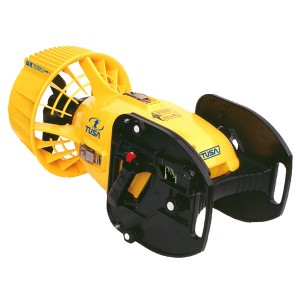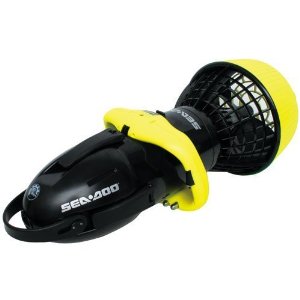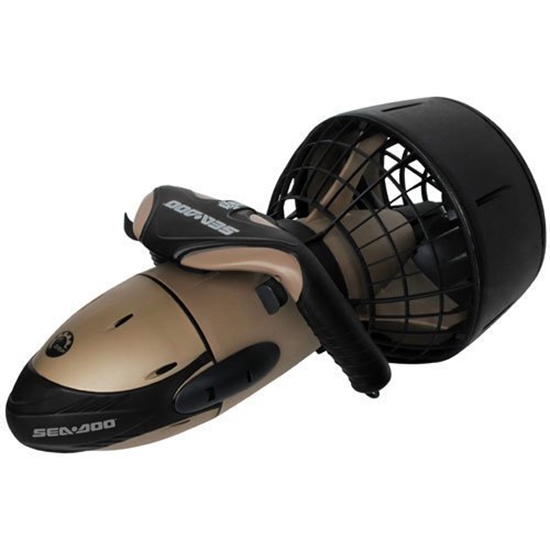Scuba Diving Equipment & Scuba Gear Reviews
Welcome to Underwater Sea Scooter HQ! Are you looking for reviews and ratings on the some of the Best Underwater Sea Scooters & SCUBA gear?
Well, you’ve come to the right place!
On this site, you will find independent fact-based underwater sea scooter DPV reviews of the best scooters on the market today, plus advice on how to choose the best underwater scooter for your needs.
What is a Underwater Sea Scooter DPV?
A underwater sea scooter or diver propulsion vehicle (also known as DPV ) is an item of diving equipment used by scuba and snorkeling divers to increase their range and distance underwater. Range is restricted by the amount of breathing gas that can be carried, the rate at which that breathing gas is consumed under exertion, and the time limits imposed by the dive tables to help avoid decompression sickness.
A underwater scooter DPV usually consists of a pressure resistant watertight casing containing a battery powered electric motor, which drives a propeller. The design must ensure that the propeller cannot harm the diver, diving equipment or marine life, the vehicle cannot be accidentally started or run away from the diver, and it remains neutrally buoyant while in use underwater.
How Underwater Sea Scooters Work:
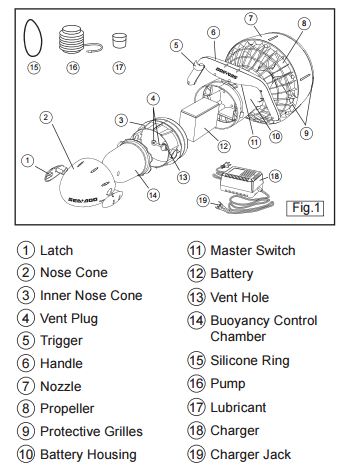 A underwater scooter diver propulsion vehicle is really quite basic in design with an electric motor that is battery powered. Behind the motor is the propeller which has a protective grille or cage so that no diving equipment or body parts can get entangled with the propeller unit.
A underwater scooter diver propulsion vehicle is really quite basic in design with an electric motor that is battery powered. Behind the motor is the propeller which has a protective grille or cage so that no diving equipment or body parts can get entangled with the propeller unit.
Most underwater sea scooters will have dual trigger controls that create some extra operating caution and provides extra safety purpose by using the auto shut off during operation. The waterproof circuitry is a key feature on sea scooters – obviously you don’t want water to harm the inner electronic workings of the scooter.
Buoyancy is another important factor that all divers and snorkelers need to consider. The more buoyant the DPV is the more you will need to work to keep it underwater and going in the direction you want (down or even in a straight line). The Sea Doo GTI Sea Scooter has an adjustable buoyancy making dives of all depths much easier.
As for speeds, the smaller less expensive units we found run at 1 MPH and it’s meant for kids 8-10 years of age – basically a training tool for future snorkeling and diving. The Sea Doo Dolphin goes up to 2 MPH and still meant for swimming pools and basic snorkeling along the waters surface. The larger more exspensive units can reach speeds up to 3-4 MPH with a run time of 2 hours.
Sea scooters are compact and lightweight so they are easily to lift around and store away. You should be able to fit a sea scooter into any normal vehicle for easy transportaion to and from your dive. Sea scooters are not very complicated by design and easy routine maintenance can be performed ( and needs to be performed ) per the owners manual on a routine basis.
10 Great Reasons To Buy a Underwater Sea Scooter:
Lightweight and efficient, sea scooters are an ideal accessory for scuba divers, snorkelers, swimmers and anyone else interested in water sports
Here are ten awesome reasons why a underwater sea scooter is worth the investment:
1. Very maintenance-friendly
2. Easy to transport
3. Low operating cost
4. Extends diving range
5. Extremely efficient
6. Super simple operation
7. Saves energy during dive
8. Explore more less fatigue and less air needed
9. Drop it in the water & go
10. Great for young or old
That said, there are dozens of models to choose from that cost $200 to $2,000. Which makes selecting a perfect underwater scooter confusing for even the most dedicated online shopper.
To help simplify your shopping, we offer several ways to learn about the best underwater sea scooters in the market, including:
View our side-by-side comparison of the Top Sea Scooter Comparison Chart .
Five Best-Selling Underwater Sea Scooters We Like
For more top-rated sea scooters see our side-by-side comparison of the top 5 underwater sea scooters today.
Tusa SAV-7 EVO2 Underwater Scooter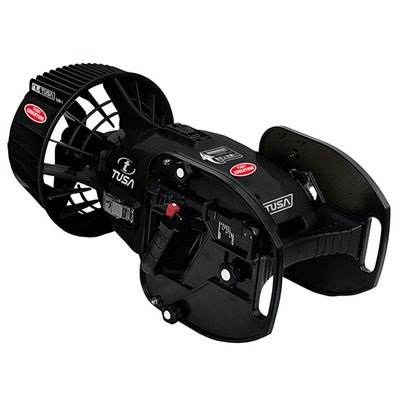
The Tusa Sav 7 Evo is by far my personal favorite DPV, hands down. Why? It’s so very well built and very reliable but it has some great improved features over it’s sister sea scooter the Tusa SAV-7. The Tusa Sav-7 Evo saddle allows for natural, hands free riding. The scooter rests between your legs and pushes you effortlessly through the water allowing both hands free. If you are into underwater photography, videography, and spearfishing then the Tusa Sav-7 Evolution is best suited for those underwater scooter activities.
New Hollis H-160 Sea Jet DPV Scooter
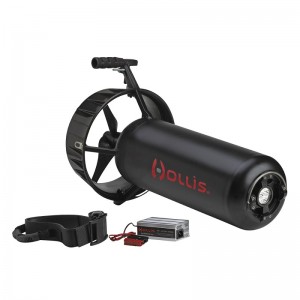 This new innovative DPV sets the standard and raised the bar in DPV tow behind vehicles. With 45lbs of thrust and a depth rating of 656ft the H-160 is the DPV of choice. With removable trim weights you have the perfect trim for salt or fresh water diving. The H-160 is operable with one hand and has a trigger switch that allows divers to vary between power settings of 50%, 75% or 100%. You select the power setting and use the thumb lock to set the underwater cruise control. All of these features make the H-160 the DPV of choice for cave, wreck, and recreational diving.
This new innovative DPV sets the standard and raised the bar in DPV tow behind vehicles. With 45lbs of thrust and a depth rating of 656ft the H-160 is the DPV of choice. With removable trim weights you have the perfect trim for salt or fresh water diving. The H-160 is operable with one hand and has a trigger switch that allows divers to vary between power settings of 50%, 75% or 100%. You select the power setting and use the thumb lock to set the underwater cruise control. All of these features make the H-160 the DPV of choice for cave, wreck, and recreational diving.
The Tusa SAV – 7 sea scooter is a slightly older model of and has been known to provide high quality equipment over the years. Even though this underwater scooter is a model that has been around a few years, the fact is that it’s still hanging around and being sold due to the outstanding quality, and durability of the diving scooter.
Sea Doo Explorer X Sea Scooter
It’s hard to get much better than the outstanding Sea Doo Explorer X sea scooter. Its designed for deep water diving with a max speed over 3 MPH and a depth of 130 feet. It offers a 3 stage speed control function with auto shutoff operation which is perfect for all types of dives. The pressure valve technology helps the unit depressurize. With a battery life run time of up to 2 hours per charge, you should have plenty of time to explore the underwater treasures.
Sea Doo VS Supercharged “PLUS” Sea Scooter
The SEA-DOO sea scooter VS Supercharged Plus has been developed for the more serious diver, it has a much more durable feel. This ultimate dive propulsion vehicle has been rated No.1 overall by Diving Science and Technology (DSAT) group. Built around portability and performance this nice sea scooter is designed to push your diving experience to a new level of excitement.
Watch a Sea Doo Underwater Sea Scooter in Action!
If You Are Short on Time
Although I would consider my articles to be pretty concise, I realize that some of you may not have the time to read through all of the reviews I have written. If that’s the case, I have done the hard part for you and prepared a comparison table which provides you with a brief overview of all the underwater sea scooters I have included. In it you will find performance and other notable features.
Another shortcut for quickly selecting the correct underwater scooter is my selection below of best underwater sea scooters 2016, which I picked on specific performance and price. Or you may wish to browse through some of the more detailed sea scooter reviews listed below.
The What’s What of Underwater Sea Scooters
If you’re reading this it means you’re still on board, and that’s great. It also means that you’re looking for some additional information before you go ahead and buy your next underwater sea scooter or maybe a GoPro camera to go with it. I know there are plenty of things to take into account such as speed, power, safety features, and much more. If you’re not familiar with these terms, don’t worry because the following articles are here to guide you through the world of underwater sea scooters and DPV’s.
Buying Guide
I would recommend you start by reading my buying guide which I wrote with the goal of shedding some light on the most important features and functionalities of underwater sea scooters. Once you’ve gotten yourself acquainted with all the crucial facts and terms, you can go onto read other informational articles here on my website.
Things to Consider
- Buoyancy. Buoyancy is usually a neutral to slight positive depending on the model. With a slight positive buoyancy ensures that if scooter is left unattended, it will slowly reach the surface. Neutral buoyancy is used mostly for professional underwater scooters, when left unattended but connected to the diver, it will float freely in the water and will not disturb the diver at work by pulling him up or down.
- Size of underwater scooters. They vary from small pool toys for kids to professional underwater scooters. Small scooters weigh 12 pounds and can pull single diver at limited speed and usually have limited endurance (30 minutes maximum, maybe little bit more if not pushed too hard). Larger underwater scooters weigh up to 20-30 pounds and can easily be handled with one adult on the boat deck or shoreline area.
- Depth range. This can vary from several meters to 40 meters. At 40 meters this is a safe limit for safe scuba diving using ordinary air for breathing. Even then, one must use diving tables for decompression, unless dives were rather short (again, for safety reasons, check diving tables). If you are free diver, then use these devices according to your maximum diving depth and be very careful.
- Power output. Batteries can vary from a few hundreds watts to few kilowatts. The stronger engine doesn’t mean more noise, since expensive models usually have better acoustic insulation, better bearings and better and larger propellers. Smaller underwater scooters often have high-pitch sound due to use of smaller, faster rotating electric motor and propeller. The energy source is almost exclusively batteries with the most common batteries being the NiCd, NiMH, LiPo and various lithium batteries.
- Endurance. Again this depends on the size of the scooter, battery type, size, capacity, and the way the scooter is used. When scooter is pushed heavily and driven hard, it drains the battery fast, with running times often less than 10-15 minutes for cheap models. On the other hand, big scooters equipped with lithium batteries and large propellers, when used for slower diving around, can last for hours. Most of the these devices have rechargeable batteries that are easily replaced. Always a good idea to have multiple batteries on charge to help extend your scooter usage.
- Scooter prices. This can vary from $100 or so dollars on up to several thousands (or even more) dollars in the most professional sea scooters. Those cheap ones are barely more than pool toys, while expensive ones are professional grade equipment that can withstand severe usage in a more hostile environment. If you have such expensive equipment (designed to be used by professional divers in extreme environments) and you use it carefully and maintain it as required, it performs flawlessly for long period of time.

